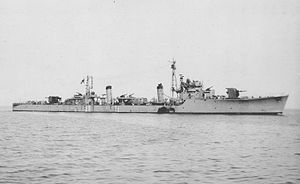This is an old revision of this page, as edited by Sturmvogel 66 (talk | contribs) at 09:33, 7 November 2020 (→top). The present address (URL) is a permanent link to this revision, which may differ significantly from the current revision.
Revision as of 09:33, 7 November 2020 by Sturmvogel 66 (talk | contribs) (→top)(diff) ← Previous revision | Latest revision (diff) | Newer revision → (diff) For other ships with the same name, see Japanese ship Kaya. Sister ship Momi, 4 September 1944 Sister ship Momi, 4 September 1944
| |
| History | |
|---|---|
| Name | Kaya |
| Builder | Maizuru Naval Arsenal |
| Laid down | 10 April 1944 |
| Launched | 30 July 1944 |
| Completed | 30 September 1944 |
| General characteristics (as built) | |
| Class and type | Template:Sclass- escort destroyer |
| Displacement | 1,282 t (1,262 long tons) (standard) |
| Length | 100 m (328 ft 1 in) (o/a) |
| Beam | 9.35 m (30 ft 8 in) |
| Draft | 3.3 m (10 ft 10 in) |
| Installed power | 2 × water-tube boilers; 19,000 shp (14,000 kW) |
| Propulsion | 2 shafts, 2 × geared steam turbines |
| Speed | 27.8 knots (51.5 km/h; 32.0 mph) |
| Range | 4,680 nmi (8,670 km; 5,390 mi) at 16 knots (30 km/h; 18 mph) |
| Complement | 210 |
| Sensors and processing systems | |
| Armament |
|
Kaya (榧, "torreya nucifera") was one of 18 Template:Sclass- escort destroyers built for the Imperial Japanese Navy (IJN) during World War II. Completed in late 1944, the ship began convoy escort duties in October. She was slightly damaged by American aircraft while escorting cruisers on a bombardment mission in the Philippines during Operation Rei in December. Kaya spent the rest of the war escorting convoys and capital ships after repairs.
The ship was surrendered to the Allies at the end of the war and used to repatriate Japanese troops until 1947.
Design and description
Designed for ease of production, the Matsu class was smaller, slower and more lightly armed than previous destroyers as the IJN intended them for second-line duties like escorting convoys, releasing the larger ships for missions with the fleet. The ships measured 100 meters (328 ft 1 in) long overall, with a beam of 9.35 meters (30 ft 8 in) and a draft of 3.3 meters (10 ft 10 in). Their crew numbered 210 officers and enlisted men. They displaced 1,282 metric tons (1,262 long tons) at standard load and 1,554 metric tons (1,529 long tons) at deep load. The ships had two Kampon geared steam turbines, each driving one propeller shaft, using steam provided by two Kampon water-tube boilers. The turbines were rated at a total of 19,000 shaft horsepower (14,000 kW) for a speed of 27.8 knots (51.5 km/h; 32.0 mph). The Matsus had a range of 4,680 nautical miles (8,670 km; 5,390 mi) at 16 knots (30 km/h; 18 mph).
The main armament of the Matsu-class ships consisted of three 127-millimeter (5 in) Type 89 dual-purpose guns in one twin-gun mount aft and one single mount forward of the superstructure. The single mount was partially protected against spray by a gun shield. The accuracy of the Type 89 guns was severely reduced against aircraft because no high-angle gunnery director was fitted. The ships carried a total of 25 Type 96 25-millimeter (1 in) anti-aircraft guns in 4 triple and 13 single mounts. The Matsus were equipped with Type 13 early-warning and Type 22 surface-search radars. The ships were also armed with a single rotating quadruple mount amidships for 610-millimeter (24 in) torpedoes. They could deliver their 36 depth charges via two stern rails and two throwers.
Construction and career

Authorized in the late 1942 Modified 5th Naval Armaments Supplement Program, Kaya was laid down on 10 April 1944 at the Maizuru Naval Arsenal and launched on 30 July. Upon her completion on 30 September, Kaede was assigned to Destroyer Squadron 11 of the Combined Fleet for training. The ship began performing escort missions beginning in November 1944. In December the ship took part in the bombardment of San Jose before returning to Japan, where she surrendered.
Notes
- Stille, p. 38
- ^ Chesneau, p. 196
- Stille, p. 45
- Whitley, p. 206
- Jentschura, Jung & Mickel, p. 151
- ^ Stille, p. 41
- Jentschura, Jung & Mickel, p. 152
- Stille, p. 40
- Nevitt
Bibliography
- Chesneau, Roger, ed. (1980). Conway's All the World's Fighting Ships 1922–1946. Greenwich, UK: Conway Maritime Press. ISBN 0-85177-146-7.
- Dodson, Aidan & Cant, Serena (2020). Spoils of War: The Fate of Enemy Fleets after Two World Wars. Barnsley, UK: Seaforth Publishing. ISBN 978-1-5267-4198-1.
- Jentschura, Hansgeorg; Jung, Dieter & Mickel, Peter (1977). Warships of the Imperial Japanese Navy, 1869–1945. Annapolis, Maryland: United States Naval Institute. ISBN 0-87021-893-X.
- Nevitt, Allyn D. (1998). "IJN Kaya: Tabular Record of Movement". www.combinedfleet.com. Retrieved 21 September 2020.
- Rohwer, Jürgen (2005). Chronology of the War at Sea 1939–1945: The Naval History of World War Two (Third Revised ed.). Annapolis, Maryland: Naval Institute Press. ISBN 1-59114-119-2.
- Stille, Mark (2013). Imperial Japanese Navy Destroyers 1919–45 (2): Asahio to Tachibana Classes. Botley, UK: Osprey Publishing. ISBN 978-1-84908-987-6.
- Whitley, M. J. (1988). Destroyers of World War Two: An International Encyclopedia. Annapolis, Maryland: Naval Institute Press. ISBN 0-87021-326-1.
| Matsu-class destroyers | |
|---|---|
| |
| |